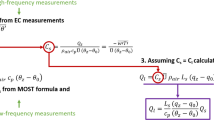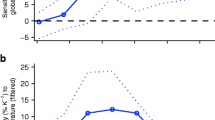Summary
In order to improve prediction of some model output, an approach for the incorporation of dynamical entrainment and forced lifting into a 1-D cloud model is introduced.
It is shown that:
-
1.
The new parameterization of entrainment processes causes oscillations in the magnitudes of the vertical velocities, rain water content and temperature perturbations.
-
2.
The forced lifting component nonlinearly amplifies vertical velocities, temperature perturbations and rain water production. It causes descents of the local maxima (positive and negative) of the parameters mentioned.
-
3.
Model values of cloud top heights and radar reflectivity maxima with new parameter of entrainment are in better agreement with observations than former ones. The rain water mixing ratio maxima under influence of forced lifting component coincide well with observed regions of rainfall maxima.
Similar content being viewed by others
References
Ackerman, B., Sun, R. Y., 1985: Prediction by two onedimensional cloud models: A comparison.J. Climate Appl. Meteor.,24, 617–628.
Anthes, R. A., 1977: A cumulus parameterization scheme utilizing a one-dimensional cloud model.Mon. Wea. Rev.,105, 270–286.
Asai, T., Kasahara, A., 1967: A theoretical study of the compensating downward motions associated with Cumulus clouds.J. Atmos. Sci.,24, 487–496.
Battan, L. J., 1982: The variable nature of thunderstorm updrafts and precipitation. In:Cloud Dynamics (eds. Agee, E. M., Asai, T.), Dordrecht: D. Reidel, 233–242.
Browning, K. A., 1977: The structure and mechanisms of hailstorms.Meteor. Monogr.,38, 1–43.
Charba, J., 1974: Application of gravity current model to analysis of squall-line gust front.Mon. Wea. Rev.,102, 140–156.
Ćurić, M., 1980: Dynamics of a cold air outflow from the base of the thunderstorm. A simple model.J. Rech. Atmos.,14, 493–498.
Ćurić, M., 1982: The development of the cumulonimbus cloud which moves along a valley. In:Cloud Dynamics (eds. Agee, E. M., Asai, T.). Dordrecht: D. Reidel, 259–272.
Ćurić, M., 1985: Inclusion of the local orographic conditions in one dimensional numerical model of Cb cloud.Zbornik meteor. i hidrol. radova,12, 156–159.
Ćurić, M., 1986: Areal characteristics of different precipitation type from Cumulonimbus in North-Western part of Serbia, Proceedings from 19 International Conference for Alpine Meteorology, Austrian Meteorological Service, Wien, 51–54.
Dye, Y. E., Jones, J. J., Winn, W. P., Cerni, T. A., Gardiner, B., Lamb, D., Pitter, R. L., Hallett, J., Sounders, C. P. R., 1986: Early electrification and precipitation in a small, isolated Montana cumulonimbus.J. Geophys. Res.,91, 1231–1247.
Goff, R. C., 1976: Vertical structure of thunderstorm out-flows.Mon. Wea. Rev.,104, 1429–1440.
Kessler, E., 1969: On the distribution and continuity of water substance in atmospheric circulations.Meteor. Monogr.,32, Amer. Met. Soc., 84 pp.
Lin, J. Y., Orville, H. D., 1969: Numerical modelling of precipitation and cloud shadow effects on mountain-induced cumuli.J. Atmos. Sci.,26, 1283–1298.
Lin, Y. J., Farley, R. D., Orville, H. D., 1983: Bulk parameterization of the snow-field in a cloud model.J. Climate Appl. Meteor.,22, 1065–1092.
List, R., Lozowski, E. P., 1970: Pressure perturbations and buoyancy in convective clouds.J. Atmos. Sci.,27, 168–170.
Locatelli, J. D., Hobbs, P. V., 1974: Fall speeds and masses of solid precipitation particles.J. Geophys. Res.,79, 2185–2197.
Lopez, R. E., 1973: A parametric model of cumulus convection.J. Atmos. Sci.,30, 1354–1374.
Miller, L. J., 1975: Internal airflow of a convective storm from dual-Doppler radar measurements.Pure Appl. Geophys.,113, 765–786.
Musil, D. J., May, E. L., Smith, P. L., Sand, Jr. W. R., 1976: Structure of an evolving hailstorm, Part IV: Internal structure from penetrating aircraft.Mon. Wea. Rev.,104, 596–602.
Newton, C. W., Newton, H. R., 1959: Dynamical interaction between large convective clouds and environment wind vertical shear.J. Meteor.,16, 483–496.
Orville, H. D., Kopp, F. J., Myers, C. G., 1975: The dynamics and thermodynamics of precipitation loading.Pure. Appl. Geophys.,113, 983–1004.
Ray, P. S., Ziegler, C. L., Bumgarner, W., Serafin, R. J., 1980: Single and multiple Doppler radar observations of tornadic storms.Mon. Wea. Rev.,108, 1607–1625.
Srivastava, R. C., 1967: A study of the effect of precipitation on cumulus dynamics.J. Atmos. Sci.,24, 36–45.
Wakimoto, M. R., 1982: The life cycle of thunderstorm gust fronts as viewed with doppler radar and rawinsonde data.Mon. Wea. Rev.,110, 1060–1082.
Wang, Y. C., 1983: A quasi-one dimensional, time dependent and non precipitating cumulus cloud model. On the bemodal distribution of cumulus cloud height.J. Atmos. Sci.,40, 651–664.
Weinstein, A. J., 1970: A numerical model of cumulus dynamics and microphysics.J. Atmos. Sci.,27, 246–255.
Wisner, C., Orville, H. D., Myers, C., 1972: A numerical model of a hail-bearing cloud.J. Atmos. Sci.,29, 1160–1181.
Author information
Authors and Affiliations
Additional information
With 10 Figures
Rights and permissions
About this article
Cite this article
Ćurić, M., Janc, D. A forced 1-D convective cloud model. Meteorl. Atmos. Phys. 39, 51–62 (1988). https://doi.org/10.1007/BF01029897
Received:
Revised:
Issue Date:
DOI: https://doi.org/10.1007/BF01029897




